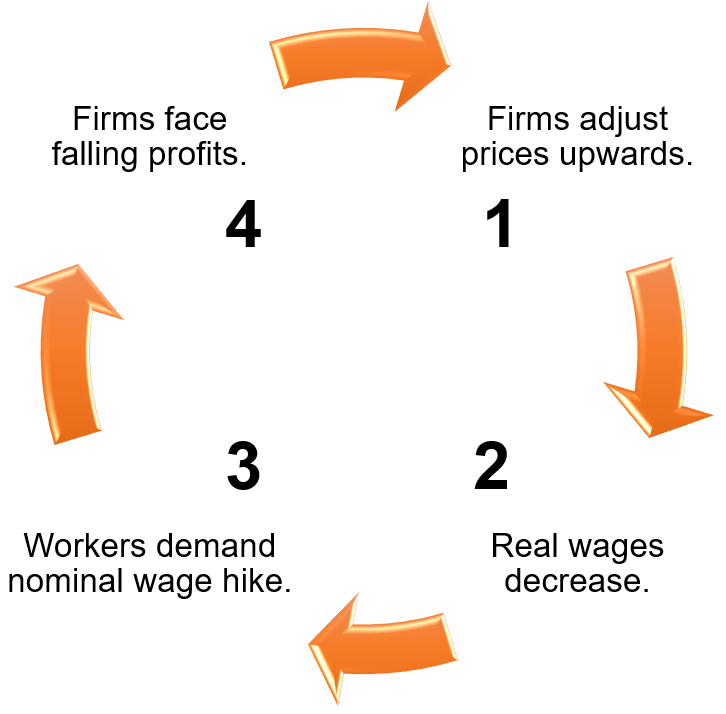I know I am probably repeating myself with “Economics disciples should know” – but it would probably be apt to point that out again with regards to the Wage-Price Spiral.
Strangely though, the Wage-Price spiral seldom gets as much bad rep as it should (in theory) amongst “A” level students in essays explaining the evils of inflation. Similar observations can be made for the purported ills of deflation and the Deflationary Spiral.
A question begs to be asked: Who’s to decide the most evil of them all?
Well, at least to me, MAS (Monetary Authority of Singapore) is not a worst choice for an answer, and here’s what one of its publications had to say about major concerns to unanticipated inflation:
When workers observe that the prices of goods and services have risen, they will ask for higher wages to maintain their purchasing power and if employers accede to this demand, they will have to charge higher prices for their goods and services in order to cover the higher wage cost. If this then leads to further wage demands and price increases, the result is a wage-price spiral, which is very difficult to reverse.
And with that fairly brief and bland description of Macroeconomic Armageddon, MAS’ publication has done a pretty good job of explaining what the Wage-Price Spiral is. It can be extremely simplified to this:

MAS scare-mongering?
At first glance, the text by MAS appears to suggest that any hint of inflation that isn’t stamped out quickly enough would lead to this vicious cycle of sustained price increases.
In reality, it isn’t so straightforward (otherwise I won’t be spending time writing about it).
First, we should be clear that the fear of the Wage-Price Spiral is strongly determined by 3 key factors:
- Its ill-effects;
- The difficulties of exiting such a situation; and
- The likelihood of entering such a situation in the first place.
Few will dispute the first point – history is replete with examples that have seared themselves into collective memories, and the Google search engine.
Not many too, will dispute the second point. Logic dictates of course that problems should be tackled at their roots (i.e. stamp out whatever ailed prices to begin with – Step 1 in the diagram).
Reality however dictates that the Central Banks should still try something with their respective Macroeconomic tools of choice. I had previously discussed about why this happens although such actions often spawn further problems down the road.
Things get murkier, however, when it comes to the third point.

Leak 1: Imports.
The strength of the feedback mechanism driving the Wage-Price Spiral depends on the size of “leakages” from the cycle. In particular, with an open economy like Singapore’s, prices are influenced to a large extent by the global market, in addition to local cost pressures.
Simply put, it is not a given that higher wages will lead to higher prices in Singapore. The actual process is more nuanced.
For example, we are likely to see the Wage-Price Spiral feature most prominently in private transport and housing prices. This is because their major cost components (COE and land price respectively) are “Made-In-Singapore” and subject to strong bidding effects, which are influenced by income levels to a large extent, for the given supply constraints.
Interestingly, in most discussions, MAS prefers to utilise “core” inflation rather than “headline” inflation, the difference being the latter’s inclusion of both afore-mentioned private transport and accommodation costs. Ostensibly, this is due to strong supply-side influences from the government (COE quota and land development planning) screwing up measures of “overall” price movements.
Consider the typical household expenditure mix, and ignore private transport and accomodation costs for now:
In general, especially when it comes to goods, the transactions in Singapore are more likely to resemble this:

Even for services, where there is greater likelihood of “local content” (think hairdressing, local entertainment services etc), in reality there is a large volume of trade with our international trading partners. Roughly half-a-trillion SGD annually in fact – read more about relevant statistics here.
In short, the large volume of imports, and the fact that much of local production is exported, implies a significant weakening of the Wage-Price Spiral. Global economic performance is likely to play an out-sized role in determining wage and price levels in Singapore.
Curiously therefore, the use of core inflation in this case, runs counter to the supposed need to be wary about the Wage-Price Spiral. I am personally inclined to chalk this up as a bit of narrative conflict, and one that’s easy to resolve with some basic understanding of the metrics involved.
Leak 2: Local labour cost proportion.
We can see this point very clearly by considering 2 extreme (and obviously unlikely) scenarios where:
- Local labour cost represents 100% of production cost; and
- There is no local labour cost in production.
In the former’s case, the labour-cost-to-price transmission would be perfect, and the Wage-Price spiral would develop very easily. Whereas in the case of the latter, it would prove extremely difficult. Both cases assume rational behaviour from the economic agents of course.

This is similar to the previous analysis I had done with regards to the interactions of crude oil prices and retail petrol prices in Singapore, where the dilution of raw material costs weaken the price transmission between crude and retail oil prices.
Publicly-available data about the ratio of local labour cost to prices is hard to come by – so if you know it may be sourced from, please let me know in the Comments section below. For now though, it would seem reasonable to assume that local labour costs represent a significant proportion of production costs, and therefore price levels.
If so, given MAS’ concerns about the Wage-Price Spiral, this contribution to the likelihood of the Wage-Price Spiral developing should not be overlooked by Singapore’s technocrats, and as we will see in the next article, this has indeed been the case.
For now though, it suffices for us to see that local labour content in production cost is a significant factor in determining the strength of the Wage-Price feedback mechanism, and a major cause for concern to Singapore, unlike the case of global trade as previously discussed.
Expectations to inflation.
We step aside from the “different ways to leak” for now, and consider now that a fundamental requirement for the Wage-Price Spiral to develop (and persist) would be expectations of inflationary pressures by consumers and firms.
There are 3 reasons why expectations to inflation, especially persistent ones, can be frightening:
- They directly drive the sequential hiking between price and wage levels;
- The self-fulfilling prophecies that follow, further hardens expected inflationary pressures; and
- Expectations, though starting originally from prevailing information, can often be far-removed to the point of market hysteria under certain conditions.
It stands to reason therefore that it would be a good idea for MAS to tamp down inflation early, and keep up the image of being in control.

Already some foreboding signs can be seen with frequent allusions to stagnating wages and ever-increasing prices in coffeeshop talks. Perhaps the key silver-lining in the persistent expectations to inflation in Singapore is that nobody expects the economy to drop dead suddenly (choi!) and the economic pattern albeit depressing for some, is stably so.
However, constant wariness of ever-present inflation, whether driven by higher local wages or not, will eventually drive a Wage-Price Spiral of a different sort from the traditional one we have discussed above. After all, the starting point of the quest for appreciating assets that can hedge against, or even better inflations rates, will come from higher wages in many cases.
Cue the development of the Wage-Price Spiral.
Final word.
In the end, it appears reasonable to conclude that there are good reasons why the Wage-Price Spiral is considered to be a major problem in “A” level Economics, contrary to its lack of appearance in students’ essays.
This makes even more sense when considering various postures adopted by the Singapore economy, like its continued reliance on imported labour and its penchant for global trade participation.
Were these partly responses to the fear of the Wage-Price Spiral? Or were the up-to-now-somewhat-benign inflationary pressures in fact, the side-effects of broader economic wisdom?
We explore these in the next article.


